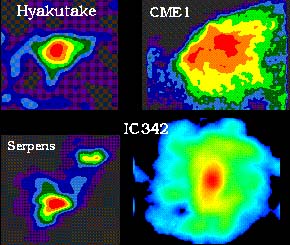| . |  |
. |
 Millimeter-Wave Telescope Closes
Millimeter-Wave Telescope ClosesKitt Peak - February 23, 2000 - The National Radio Astronomy Observatory (NRAO) will close down its millimeter-wavelength telescope on Kitt Peak, Arizona, on July 1, 2000. The closure will affect the activities of 24 NRAO employees. The Arizona telescope, known as the 12 Meter Telescope because of the diameter of its dish antenna, is the only millimeter-wavelength instrument in the U.S. that is operated full-time as a national facility, open to all scientists. The action was made necessary by the current and anticipated budget for the Observatory. Director Paul Vanden Bout said "We are forced to reduce the scope of our activities." The NRAO also operates the Very Large Array and Very Long Baseline Array from its facilities in New Mexico and is completing construction of the Green Bank Telescope in West Virginia. The 12 Meter Telescope is used to observe electromagnetic radiation with wavelengths of a few millimeters down to one millimeter, a region that lies between what is traditionally considered radio waves and infrared radiation. The NRAO is currently participating in an international partnership to develop the Atacama Large Millimeter Array (ALMA), an array of 64 antennas to observe at millimeter wavelengths from a 16,500-foot-high location in northern Chile. "We understood that ALMA eventually would replace the 12 Meter Telescope, but we had hoped to continue operating the 12 Meter until ALMA began interim operations, probably sometime in 2005. That is not possible, and we are forced to close the 12 Meter this year," Vanden Bout said. More than 150 scientists use the 12 Meter Telescope for their research every year. The NRAO's Tucson-based employees have been notified of the Observatory's decision. Some of the NRAO employees in Tucson already are working on the ALMA project. Over the next few months, the NRAO will seek to transfer 12 Meter staff to the ALMA project or to other positions within the Observatory, where that is possible. Where necessary, the Observatory will assist staff members in finding other employment, Vanden Bout said. "In the next few weeks, the Observatory will complete plans for disposing of the 12 Meter Telescope and its associated equipment. In addition, the NRAO will consult with the operators of other millimeter wavelength telescopes in an attempt to ensure that astronomers whose research depends upon such observations can obtain observing time elsewhere. "We want to mitigate the effect of this closure upon the scientific community as much as possible," Vanden Bout said.
Dozens of the different molecular species comprising the tenuous material between the stars were first detected by the 36 Foot Telescope. The most significant of these molecular discoveries was carbon monoxide, whose spectral lines are the primary signpost of the formation of new stars in galaxies. In 1984, the telescope was refurbished with a new reflecting surface and support structure. At that time, it was re-christened the 12 Meter Telescope. It continued to make landmark studies of the composition of the interstellar gas clouds and of star formation. In addition, the research program was expanded to include studies of celestial objects such as comets, evolved stars, and external galaxies. Throughout its history, the NRAO Tucson staff has continued to improve the technical capabilities of the 12 Meter Telescope, making it a more useful tool for a wider range of scientific studies. "When ALMA becomes operational, it will produce dramatic advancements in astronomy, and we look forward to those discoveries. However, the success of ALMA will be built in large part on a foundation of millimeter-wavelength expertise and achievement that came from the 12 Meter Telescope and the dedicated people who worked on it for many years. "We are sorry that the 12 Meter has to be closed now, but its place in astronomical history is secure and all those who built, maintained, operated, and observed with it can be proud of their accomplishments," Vanden Bout said. The National Radio Astronomy Observatory is a facility of the National Science Foundation, operated under cooperative agreement by Associated Universities, Inc.
TELESCOPES
|
| |||||||||
| The content herein, unless otherwise known to be public domain, are Copyright 1995-2016 - Space Media Network. All websites are published in Australia and are solely subject to Australian law and governed by Fair Use principals for news reporting and research purposes. AFP, UPI and IANS news wire stories are copyright Agence France-Presse, United Press International and Indo-Asia News Service. ESA news reports are copyright European Space Agency. All NASA sourced material is public domain. Additional copyrights may apply in whole or part to other bona fide parties. Advertising does not imply endorsement, agreement or approval of any opinions, statements or information provided by Space Media Network on any Web page published or hosted by Space Media Network. Privacy Statement All images and articles appearing on Space Media Network have been edited or digitally altered in some way. Any requests to remove copyright material will be acted upon in a timely and appropriate manner. Any attempt to extort money from Space Media Network will be ignored and reported to Australian Law Enforcement Agencies as a potential case of financial fraud involving the use of a telephonic carriage device or postal service. |